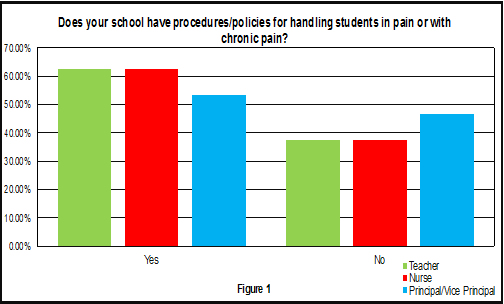Pain and Opioid Related Concerns in Schools
By Elika Salimi, BS1, Rakhi Dayal, MD1
1Department of Anesthesiology and Perioperative Care
University of California, Irvine
(Summarized and submitted by Elika Salimi, BS)
Background
Pediatric chronic pain is a significant problem with conservative estimates that point to 20-35% of children and adolescents affected by it worldwide1. Per the 2015 US National Survey on Drug Use and Health, 276,000 adolescents were current nonmedical users of pain relievers, with 122,000 having an addiction to prescription pain relievers2. The opioid epidemic problem is not unique to adults, yet children have largely been excluded from research and discussions. Our goal was to assess the extent of the problem locally, in Orange County schools.
Methods
This is an IRB approved retrospective analysis of current school resources and management strategies for pediatric pain and associated opioid use. Anonymous surveys were sent to nurses, principals, vice principals, and teachers at schools (grades 6 – 12) in Orange County, California.
Results
Of the 3,654 emails sent, we received a total of 206 responses with a combined total response rate of 5.6%. Our data represents between ~15,000 to ~28,000 students of Orange County. Surveyors pointed concern to chronic physical pain [18.9%] and psychological pain [65.5%]. 38.3% [75/196] of school staff reported that they do not have procedures/policies for handling students with pain in general [Figure 1]. Percentage of staff members who reported no experience with guiding students to manage/cope with physical pain is 36% [54/150] vs. 18% [26/144] for psychological pain.

Conclusions & Future Direction
Gaps demonstrated in our study will require renewed initiative at all levels.
In summary, empowering students, utilization of social media, and the increase of healthcare provider participation could be crucial ways of dealing with the pain and opioids epidemic. More robust healthcare measures are required to address alternatives to pain management.
References
- Friedrichsdorf, Stefan J. et al. “Chronic Pain in Children and Adolescents: Diagnosis and Treatment of Primary Pain Disorders in Head, Abdomen, Muscles and Joints.” Ed. Carl L. von Baeyer. Children 3.4 (2016): 42. PMC. Web.
- Bose J, Hedden SL, Lipari RN, Park-Lee E. Key substance use and mental health indicators in the United States: Results from the 2015 National Survey on Drug Use and Health. SAMHSA [Internet]. 2016. Available from http://www.samhsa.gov/data/


